|
|
|
Sort Order |
|
|
|
Items / Page
|
|
|
|
|
|
|
| Srl | Item |
| 1 |
ID:
167473
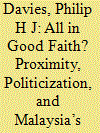

|
|
|
| 2 |
ID:
108626
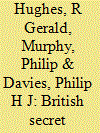

|
|
|
| 3 |
ID:
147575
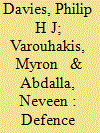

|
|
|
| 4 |
ID:
092464


|
|
|
|
|
| Publication |
2009.
|
| Summary/Abstract |
This article examines the status, role and development of imagery intelligence in the UK government. It is argued that imagery intelligence occupies a subordinate and marginalised position compared to other forms of intelligence, chiefly from human sources and the interception of communications. The origins of that position are recounted, and the problems arising from internal struggles over control of imagery examined. It is concluded that the existing approach to imagery represents a serious problem and that a substantial restructuring and upgrading of imagery intelligence is essential if UK foreign policy decision-making is to be properly informed in the 21st Century.
|
|
|
|
|
|
|
|
|
|
|
|
|
|
|
|
| 5 |
ID:
166588


|
|
|
|
|
| Summary/Abstract |
This article examines the evolution of the current British military joint intelligence doctrine. We argue that military intelligence doctrine is dogged by an intrinsic tension between the ethos and expectations of military doctrine and those of the professional practice of intelligence. We further argue not only that prior iterations of UK joint intelligence doctrine failed to effectively deal with this intelligence doctrine dilemma, but also that measures in the current doctrine to address this problem directly created their own problems. Moreover, as a result, otherwise sound innovations in the current UK intelligence doctrine have proven unsuitable to wider diffusion in more recent intelligence doctrine such as the new NATO intelligence doctrine which, otherwise, draws extensively on its British precursor.
|
|
|
|
|
|
|
|
|
|
|
|
|
|
|
|
| 6 |
ID:
092452
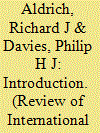

|
|
|
|
|
| Publication |
2009.
|
| Summary/Abstract |
Despite the advent of a UK National Security Strategy in 2008, there has been surprisingly little public discussion of the long-term future of the intelligence and security services, together with cognate subject of special operations.
|
|
|
|
|
|
|
|
|
|
|
|
|
|
|
|
| 7 |
ID:
188268


|
|
|
|
|
| Summary/Abstract |
Between 2009 and 2011, there was an intense debate in UK, Canadian, and Australian military intelligence circles regarding two putatively competing doctrinal concepts, the U.S.-originated “intelligence, surveillance, and reconnaissance” and the United Kingdom’s “intelligence, surveillance, target acquisition, and reconnaissance.” The inclusion, or not, of target acquisition proved a flashpoint for a wider and deeper range of existing concerns about the organizational and doctrinal relationships between intelligence and operations in a military command staff. These, in turn, reflected a more fundamental and ongoing transformation in that relationship arising from “revolution in military affairs” during the 1990s. The article traces the debate up to its premature termination by fiat in 2011 and concludes that these issues remain to be properly addressed in UK and allied intelligence doctrine.
|
|
|
|
|
|
|
|
|
|
|
|
|
|
|
|
| 8 |
ID:
147576
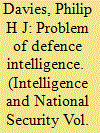

|
|
|
|
|
| Summary/Abstract |
The following article argues that defence intelligence in general, and Britain’s Defence Intelligence (DI) organization in particular, represents an area in intelligence studies that is significantly under-investigated. It makes the case that the significance of understanding defence intelligence and DI lies not only in a general lack of illumination but also because DI is subject to and prompts a range of difficulties and challenges that are either especially acute in the defence context or have ramifications for the wider intelligence community that remain to be fully appreciated. Particular attention is given to DI’s remit being divided between Ministry of Defence and national requirements, problems of fixed-sum resourcing an intelligence function with national responsibilities that is subordinate to Departmental spending structures and priorities, fraught positioning of defence intelligence in Departmental line management and, finally, a chronic lack of public or official interest or scrutiny. The article concludes that the UK’s experience has echoes elsewhere, notably in the US, and that wider international study of defence intelligence is both long overdue and may have implications for understanding of national and wider intelligence institutions and processes.
|
|
|
|
|
|
|
|
|
|
|
|
|
|
|
|
| 9 |
ID:
105692


|
|
|
| 10 |
ID:
155212


|
|
|
|
|
| Summary/Abstract |
This article examines the Brunel Iraq HUMINT Matrix exercise. The purpose of this approach to intelligence pedagogy is to get participants to think through and work out analytic methods, issues, and potential solutions from first principles and for themselves. Our strategy is to try and fuse training and education learning outcomes, so that students emerge with a technical competence in analytic methods, underpinned by a deeper understanding of the foundations and internal logic shaping those methods. The Iraq Matrix exercise seeks to unpack and examine the nuts and bolts of source evaluation, and to test alternative hypotheses with particular attention to the relationship between the quality of various sources and, the weight of judgements they can or cannot sustain. The ultimate goal is to encourage what is currently fashionably referred to as ‘reflexive practice’, whereby the practitioner reflects critically and self-critically upon how their task works and how they do it, then uses those insights to improve their workplace performance. But not all of our teaching is directed towards practitioners. For those whose aims are scholarly and academic, the aim is to give observers a more visceral understanding of the challenges of the intelligence task they intended to study. Here the intended reflexive practice goal is to encourage an empathy with the workaday challenges facing those in the business of intelligence analysis, and to discourage the observer’s temptation to make facile and simplistic judgements about processes or events.
|
|
|
|
|
|
|
|
|
|
|
|
|
|
|
|
|
|
|
|
|